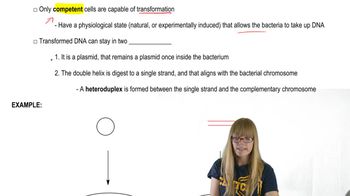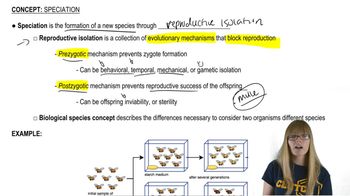Which of the following are enzymes are responsible for controlling the cell cycle?
Table of contents
- 1. Introduction to Genetics51m
- 2. Mendel's Laws of Inheritance3h 37m
- 3. Extensions to Mendelian Inheritance2h 41m
- 4. Genetic Mapping and Linkage2h 28m
- 5. Genetics of Bacteria and Viruses1h 21m
- 6. Chromosomal Variation1h 48m
- 7. DNA and Chromosome Structure56m
- 8. DNA Replication1h 10m
- 9. Mitosis and Meiosis1h 34m
- 10. Transcription1h 0m
- 11. Translation58m
- 12. Gene Regulation in Prokaryotes1h 19m
- 13. Gene Regulation in Eukaryotes44m
- 14. Genetic Control of Development44m
- 15. Genomes and Genomics1h 50m
- 16. Transposable Elements47m
- 17. Mutation, Repair, and Recombination1h 6m
- 18. Molecular Genetic Tools19m
- 19. Cancer Genetics29m
- 20. Quantitative Genetics1h 26m
- 21. Population Genetics50m
- 22. Evolutionary Genetics29m
19. Cancer Genetics
Overview of Cancer
Problem C.2c
Textbook Question
A tumor is a growing mass of abnormal cells. What must happen for a benign tumor to become malignant?
 Verified step by step guidance
Verified step by step guidance1
Understand the difference between benign and malignant tumors: benign tumors are non-cancerous growths that do not invade nearby tissues or spread to other parts of the body, while malignant tumors are cancerous and have the ability to invade and metastasize.
Recognize that for a benign tumor to become malignant, genetic changes must occur in the tumor cells that enable them to grow uncontrollably and invade surrounding tissues.
Identify that these genetic changes often involve mutations in oncogenes (genes that promote cell growth) and tumor suppressor genes (genes that inhibit cell growth), leading to loss of normal growth regulation.
Consider that additional changes may include the ability of tumor cells to evade apoptosis (programmed cell death), stimulate angiogenesis (formation of new blood vessels), and acquire the capacity to metastasize.
Summarize that the transition from benign to malignant involves a series of genetic and cellular alterations that transform the tumor cells into invasive and potentially metastatic cancer cells.
 Verified video answer for a similar problem:
Verified video answer for a similar problem:This video solution was recommended by our tutors as helpful for the problem above
Video duration:
3mPlay a video:
Was this helpful?
Key Concepts
Here are the essential concepts you must grasp in order to answer the question correctly.
Benign vs. Malignant Tumors
Benign tumors are non-cancerous growths that do not invade nearby tissues or spread to other parts of the body. Malignant tumors are cancerous, capable of invading surrounding tissues and metastasizing to distant sites, making them more dangerous and harder to treat.
Recommended video:
Guided course

Cancer Characteristics
Genetic Mutations and Cellular Transformation
For a benign tumor to become malignant, cells must acquire genetic mutations that disrupt normal growth controls. These mutations often affect oncogenes and tumor suppressor genes, leading to uncontrolled cell division, resistance to cell death, and increased potential for invasion.
Recommended video:
Guided course

Transformation
Metastasis and Invasion Mechanisms
Malignant tumors gain the ability to invade surrounding tissues and spread through the bloodstream or lymphatic system. This involves changes in cell adhesion, increased motility, and secretion of enzymes that degrade extracellular matrix, enabling cancer cells to migrate and establish secondary tumors.
Recommended video:
Guided course

Speciation

 9:46m
9:46mWatch next
Master Cancer Characteristics with a bite sized video explanation from Kylia
Start learningRelated Videos
Related Practice
Multiple Choice
427
views
2
rank
